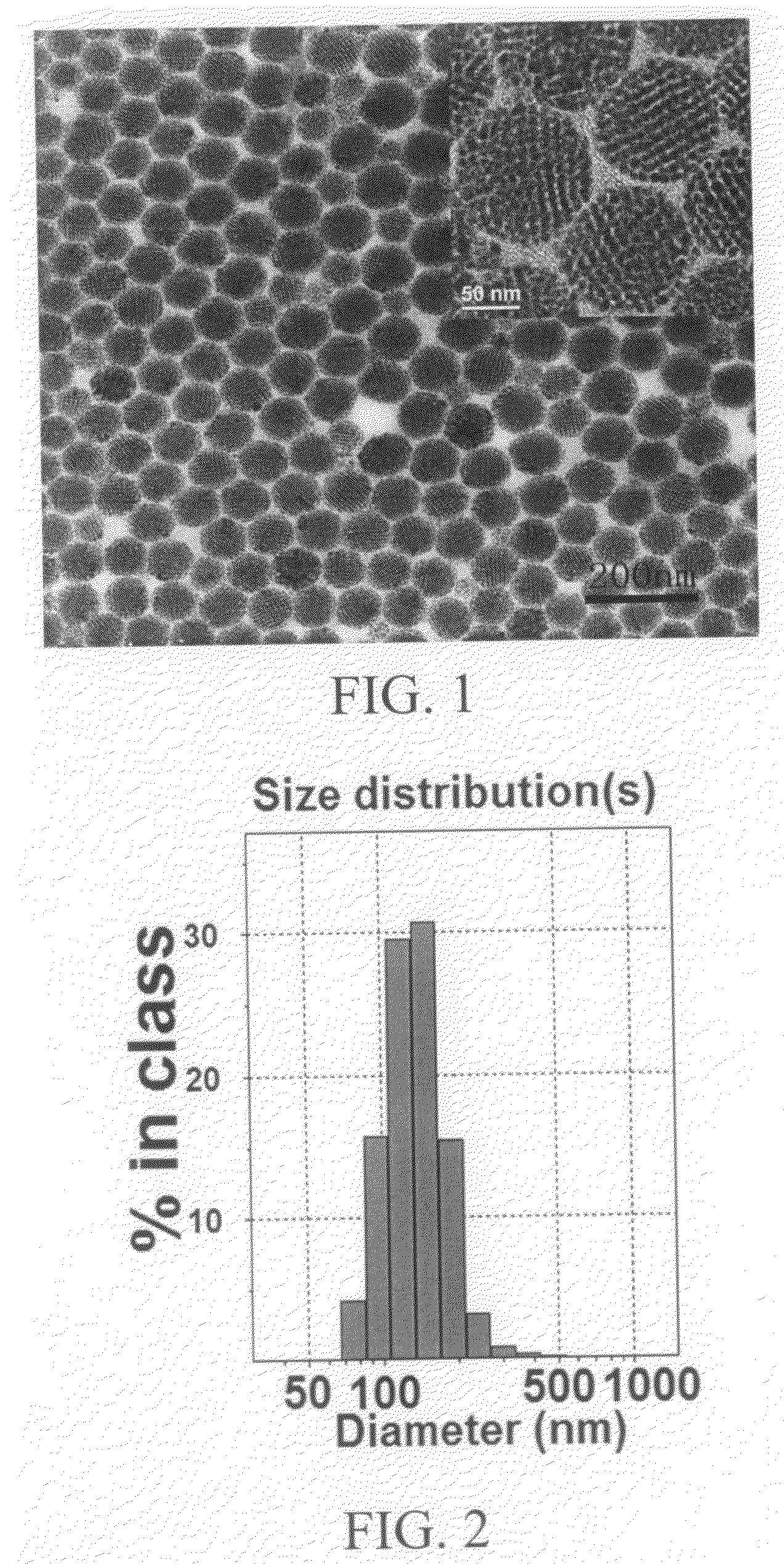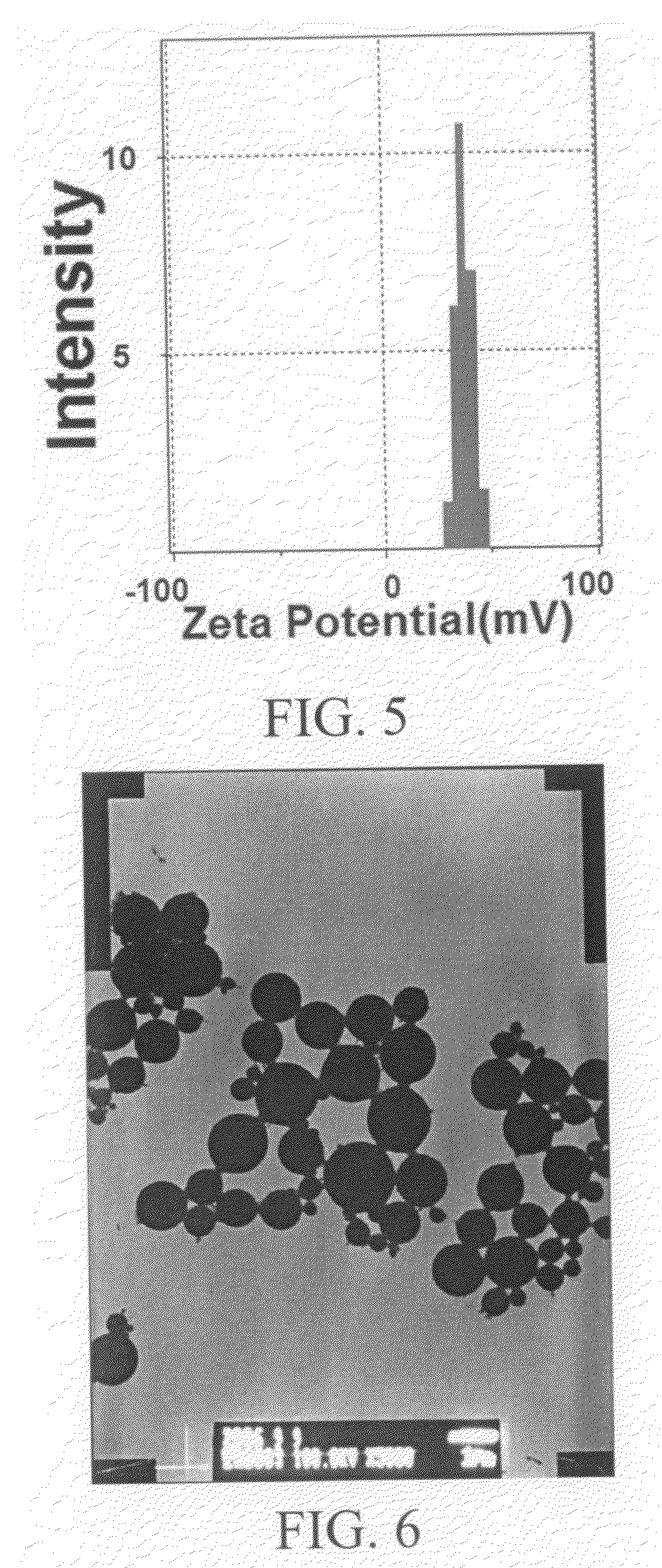Method for making colloidal nanocrystals
a nanocrystal and nanocrystal technology, applied in the field of colloidal nanocrystal making, can solve the problems of limiting the application and suitability for mass production, the crystallinity of colloidal crystals cannot be controlled, and the size distribution, etc., to achieve good size control, low toxicity, and suitable for industrial mass production
- Summary
- Abstract
- Description
- Claims
- Application Information
AI Technical Summary
Benefits of technology
Problems solved by technology
Method used
Image
Examples
example 1
[0029]Barium chromate (BaCrO4) nanocrystals coated with oleic acid are provided. The BaCrO4 nanocrystals have a diameter of about 7 nm and a dispersing coefficient of about 4.3%. The BaCrO4 nanocrystals are dissolved in an organic solvent of cyclohexane, and a cyclohexane solution with concentration of about 5 mg / ml is achieved. A surfactant of sodium lauryl sulfate (SDS) of 28 mg is dissolved in a solvent of 10 ml of deionized water , and a water solution with a concentration of about 0.01 mmol / ml is achieved. 1 ml of cyclohexane solution is mixed with the deionized water solution, further emulsified by an ultrasonic method, until a uniform and stable emulsion is achieved. Thereafter, the emulsion is heated to 70° C. for 5 h by a water heating method, in order to remove the organic solvent therefrom, and a deposit is achieved. The deposit is then washed with deionized water, and the BaCrO4 colloidal nanocrystals are achieved. Then, the BaCrO4 colloidal nanocrystals are dispersed in...
example 2
[0031]Silver selenide (Ag2Se) nanocrystals coated with octadecyl amine are provided. The Ag2Se nanocrystals have a diameter of about 10 nm and a dispersing coefficient of about 4.8%. The silver selenide (Ag2Se) nanocrystals are dissolved in an organic solvent of cyclohexane, and a cyclohexane solution with concentration of about 5 mg / ml is achieved. A surfactant of CTAB of 35 mg is dissolved in a solvent of 10 ml of deionized water , and a water solution with a concentration of about 0.01 mmol / ml is achieved. 2 ml of cyclohexane solution is mixed with 10 ml of water solution, further emulsified by ultrasonic method, until a uniform and stable emulsion is achieved. Thereafter, the emulsion is heated to 80° C. for 2 h by water heating method, in order to remove the organic solvent therefrom, and a deposit is achieved. The deposit is then washed with deionized water, and the Ag2Se colloidal nanocrystals are achieved. Then, the Ag2Se colloidal nanocrystals are dispersed in water to avoi...
example 3
[0033]The cadmium sulfide (CdS) nanocrystals coated with oleic acid are provided. The CdS nanocrystals have a diameter of about 14 nm and a dispersing coefficient of about 7.5%. The CdS nanocrystals are dissolved in an organic solvent of cyclohexane, and a cyclohexane solution with concentration of about 15 mg / ml is achieved. A surfactant of SDS of 28 mg is dissolved in a solvent of 10 ml of deionized water, and a water solution with a concentration of about 0.01 mmol / ml is achieved. 1 ml of cyclohexane solution is mixed with water solution, further emulsified by ultrasonic method, until a uniform and stable emulsion is achieved. Thereafter, the emulsion is heated to 60° C. for 10 hours by water heating method, in order to remove the organic solvent therefrom, and a deposit is achieved. The deposit is then washed with deionized water, and the CdS colloidal nanocrystals are achieved. Then, the CdS colloidal nanocrystals are dispersed in water to avoid re-aggregation.
[0034]Referring t...
PUM
| Property | Measurement | Unit |
|---|---|---|
| concentration | aaaaa | aaaaa |
| diameter | aaaaa | aaaaa |
| diameter | aaaaa | aaaaa |
Abstract
Description
Claims
Application Information
 Login to View More
Login to View More - R&D
- Intellectual Property
- Life Sciences
- Materials
- Tech Scout
- Unparalleled Data Quality
- Higher Quality Content
- 60% Fewer Hallucinations
Browse by: Latest US Patents, China's latest patents, Technical Efficacy Thesaurus, Application Domain, Technology Topic, Popular Technical Reports.
© 2025 PatSnap. All rights reserved.Legal|Privacy policy|Modern Slavery Act Transparency Statement|Sitemap|About US| Contact US: help@patsnap.com



